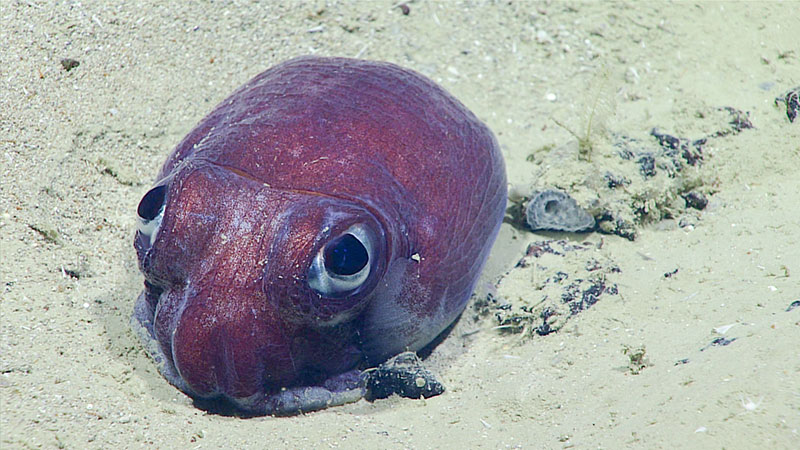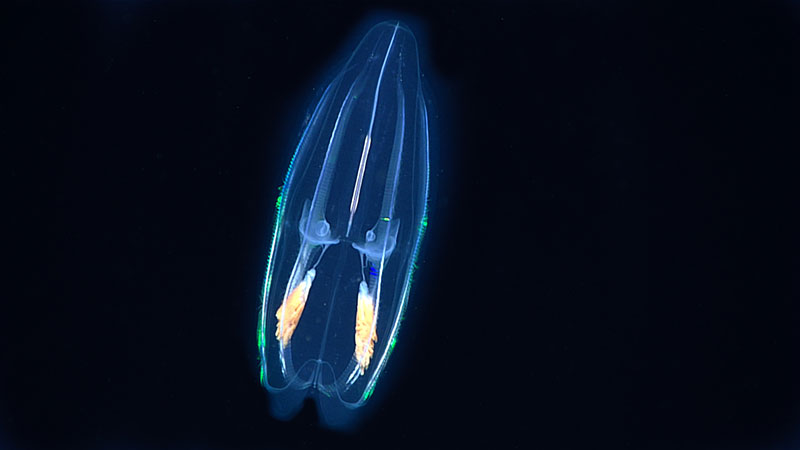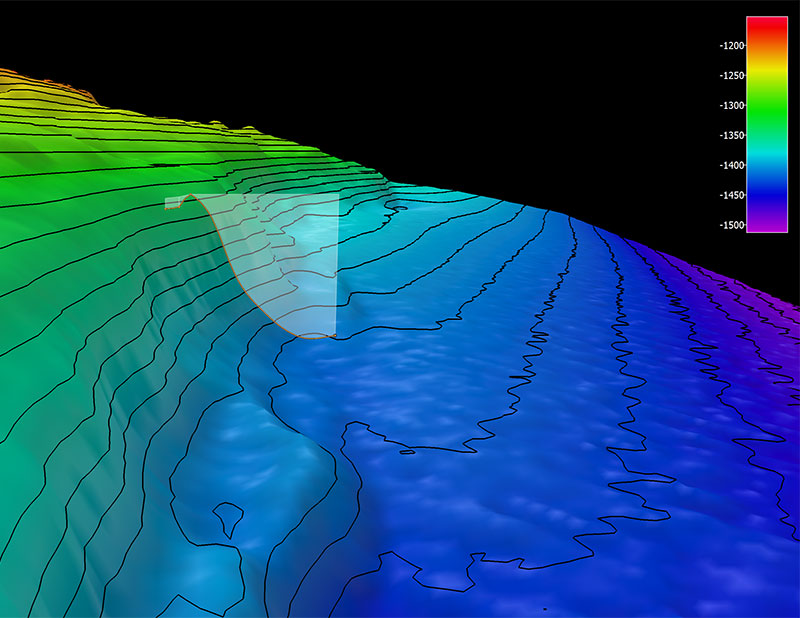
Date: June 30, 2019
Location: Lat: 31.5361°, Lon: -77.1604°
Dive Depth Range: 1,331 - 1,421 meters (4,367 - 4,662 feet)
Midwater Transect Depths: 1000, 700, and 500 meters (3,281; 2,297; and 1,640 feet)
Access Dive Summary and ROV Data

A bobtail rests on the seafloor. These cephalopods are actually not squid, but more closely related to cuttlefish. As this bobtail sits on the seafloor, it is easy to see why they are also known as ‘stubby’ or ‘dumpling’ squid. Image courtesy of the NOAA Office of Ocean Exploration and Research, Windows to the Deep 2019. Download larger version (jpg, 1.4 MB).
Our dive site today, the Blake Escarpment, was mapped by NOAA Ship Okeanos Explorer on the Windows to the Deep 2018 expedition. This site was comprised of several southern-facing scarp features, which are steep, rocky slopes of interest to biologists and geologists alike. Scarps provide unique habitat for deepwater species and insight into the area's geological history. They are also excellent places to search for deep-sea corals. Corals rely on currents to bring nutrients for food, and they require a hard substrate to begin growing. While much of the deep sea is covered in areas of soft sediment, scarps and other high-relief features tend to be rocky and experience stronger currents.
However, during today’s dive much of the seafloor observed by the remotely operated vehicle (ROV) Deep Discoverer was covered in soft sediment. We touched down below the scarp feature to find soft sediment with few rocks present. As we approached the scarp, several interesting benthic organisms were observed, including a sea cucumber and a sea star that could be the southernmost specimen observed of its species. A geologic specimen of one of the few rocks present on the seafloor was also collected.
During the ninth dive of the expedition, we encountered this octopus (Graneledone verrucosa) making its way across the seafloor. This octopus is nicknamed the "warty octopus" due to the cartilaginous bumps all over the mantle, head, and dorsal surface of the arms. Video courtesy of the NOAA Office of Ocean Exploration and Research, Windows to the Deep 2019. Download larger version (mp4, 80.8 MB).
The scarp feature also appeared to be largely covered in sediment. In the very steepest areas, there was exposed rock that appeared to be covered in manganese iron oxide crusts (common in the deep sea and also observed at other points in the dive). Once at the top of the scarp, we continued south along the contour and then west. Once again, the area was dominated by benthic organisms adapted for sediment-rich areas. Coral was not as abundant as other sites we visited on this expedition, but there was a significant amount of black coral present in areas where hard substrate was available. A sample of black coral taken on this dive will likely help scientists on shore learn more about this family and help organize the taxonomy of this group, as very few black coral specimens have been collected and very little is known about that taxa.

A ctenophore from the midwater section of Dive 09 of the Windows to the Deep 2019 expedition. The iridescent greens and blues along the outer edge are caused by light from the remotely operated vehicle lights refracting off of the hundreds of combs, or ctenes, that the ctenophore uses to swim in the water column. These ctenes are made up of many fused flagella. Ctenophores are the largest animals to use flagella as their primary means of movement. Image courtesy of the NOAA Office of Ocean Exploration and Research, Windows to the Deep 2019. Download larger version (jpg, 742 KB).
Once the benthic portion of this dive was complete, the ROV ascended to conduct several transects in the midwater. Given the depth of this site, we were able to do some deeper transects, including transects at 1000, 700, and 500 meters (3,281; 2,297; and 1,640 feet) depth. The midwater ecosystem is stratified, with ‘layers’ of pelagic organisms occupying different depths at different times of day. Doing transects at different depths helps to inform our understanding of how organisms position themselves in relation to these layers and other environmental factors.

Location of Dive 09 on June 30, 2019. Download larger version (jpg, 2.0 MB).

The remotely operated vehicle track for Dive 09, shown as an orange line with a white curtain. Scale is water depth in meters. Download larger version (jpg, 2.4 MB).